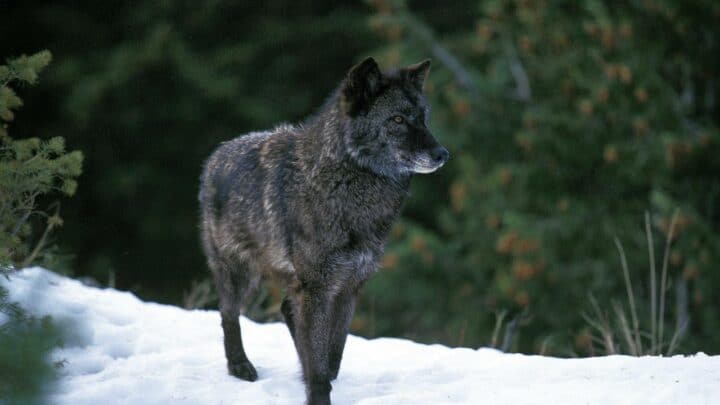Wolves are cloaked in an air of mystery, largely thanks to their portrayal in film and literature. There are no arguments here.
These enigmatic animals are endlessly fascinating, and I love learning more about them.
Most of us know that they’re the largest members of the canine family, but there are also a variety of breeds and sizes to be found within the species itself.
The Biggest Wolf Breed
Currently, the biggest wolf breed is the Mackenzie Valley Wolf. Aka the Canadian Timber Wolf or Rocky Mountain Wolf, they’re commonly found in Alaska and Western Canada, more specifically in the Mackenzie Valley area. They grow up to 7 feet long (2 meters) and weigh up to 175 pounds (80 kilograms).
What Mackenzie Valley Wolves Look Like
The body of the Mackenzie Valley Wolf is built for efficient hunting in challenging terrains. This beautiful beast is no stranger to navigating its way through thick snow and over rocky cliff edges.
Their long, thick, muscular limbs make them tall at the shoulders, and they generally grow to heights of about 32 to 40 inches (80 to 100 centimeters).
The biggest of these wolves are up to 7 feet (2 meters) long from nose to tail.
However, females are 10% to 15% smaller than their male counterparts.
What is perhaps most fascinating about these wolves, apart from their giant size, is how they have adapted to the harsh altitude of their natural habitat.
Their large chests house bigger-than-normal lungs that allow for efficient breathing in thinner air. Because of this adaptation, they possess extraordinary stamina for traveling long distances and can easily cover 70 miles (115 kilometers) of ground in a single day.
When it comes to hunting, their arsenal is nothing short of terrifying. Their heads are about 12 inches (30 centimeters) long, and they have immensely powerful jaws packed full of canines.
A muscular neck supports the wolf’s head and serves a vital role in bringing down their prey.
All that being said, they can be cute too. In the cold, Mackenzie Valley Wolves are known to cover their noses with their thick, bushy tails for warmth.
And come summer, they shed loads of their fur to keep them cool in hotter temperatures.
Their thick coats are usually gray or black, but white and tan specimens have also been observed.
The History of Mackenzie Valley Wolves
In 1829, Scottish naturalist Sir John Richardson classified the Makenzie Valley Wolf as a subspecies of the North American gray wolf.
Due to their varying coat colors, he chose to name them for the area he found them in rather than for their hue, forever immortalizing them as Canis lupus occidentalis.
Canis lupus refers to the wolf subspecies, and occidentalis means “Western.”
It is believed that these beautiful creatures are of Eurasian descent, having crossed into North America via the Bering land bridge shortly after the last Ice Age.
Reintroduction to the Yellowstone National Park
Between 1995 ad 1996, Mackenzie Valley Wolves were reintroduced into the Yellowstone National Park from Canada after it was noted that humans had all but eradicated their numbers due to gross overhunting.
Thus, eight wolves were brought from Canada to Yellowstone with the aim of controlling the elk population that had begun to erode critical plant growth to an alarming degree.
Without wolves, the ecosystem had turned out of balance.
While there was initial concern that the immigrant wolves would simply keep migrating back north, they eventually settled in and brought the elk population back under control.
Today, between 80 and 100 of these wolves are in the park, most of which are descendants of a breeding pair from the original eight, known as the Rose Creek pack.
What Mackenzie Valley Wolves Eat
Mackenzie Valley Wolves are voracious hunters with big appetites, which makes sense considering their size and how far and fast they travel.
Fortunately for them, the area they inhabit is abundant with food.
They are apex predators that feed on bison, elk, certain types of deer, mountain goats, beavers, squirrels, voles, hares, and salmon.
Usually, they hunt in packs comprising 6 to 12 members, but they can be as large as up to 20.
The greatest threat to these beautiful animals is hands down, the human being.
Frequently Asked Questions about The Biggest Wolf Breed
What is a dire wolf?
Thanks to Game of Thrones, most of us are familiar with the term “dire wolf.” Formerly the largest wolf species to roam the earth, the beautiful dire wolf is now extinct and has been for over 9000 years.
Can we keep wolves as pets?
It is illegal to own a pure wolf in North America, although some like to keep them on as exotic pets. It is also not advisable. While wolves are closely related to dogs, they are still wild animals that are instinctively fearful of humans and possess wild and unpredictable instincts.
How fast can Mackenzie Valley Wolves run?
At top speed, these wolves can run at a rate of 38 miles (60 kilometers) per hour. However, they will only keep this up in short bursts, preferring to keep their pace to a manageable light trot.
Conclusion
Wrapped in fur and shrouded in mystery, wolves have long fascinated human beings. This is likely because their link to domestic dogs is so recognizable, yet they remain outside our ambit.
Of course, one can’t help feeling awed by how well they adapted to the wild. These sleek, sophisticated hunters are a necessary part of our ecosystem and deserve to be respected as such.


